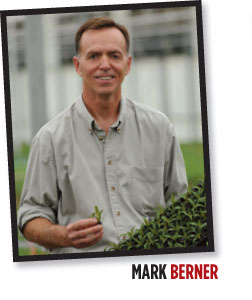11/24/2010
Growers Talk Production: Oils & Soaps
Mark Berner

I have to admit that in the past I was reluctant to use horticultural oils and soaps because of the “blow torch” stories I’d heard from other growers about burning crops, and from one particularly bad experience I had with them a long time ago. However, they’ve been improved and refined over the past 10 years or so to make them easier to use and a lot more predictable.
We routinely use both soap and oil products here at our greenhouse in our pest control program, and our usage has increased significantly the past two to three years. The increase coincides with two things: First, we started using predatory insects a number of years ago, so we had to rethink our chemical program, and choose the chemicals we use more carefully; second, the efficacy of some chemicals has come into question, most likely due to resistant pest populations. Spinosad is one example, and there are a few others that are suspect, at least here in our area of the country.
I’d like to outline what I see as the positive and negative points of horticultural oils and soaps, and explain how we use them in our greenhouse.
Positives:
- Sprayed alone, they have low toxicity and low residual effect.
- Very short, or no, REI when used alone.
- They have excellent surfactant activity. Oils and soaps break the surface tension on even the hardest-to-wet plants.
- When used as a tank-mix partner along with another insecticide, they aid in the penetration and dispersion of the other chemical(s), and seem to enhance the effects of the partner chemical(s).
- They’re inexpensive.
- They help combat resistance.
- Negatives:
- Their effects are indiscriminate. Oil and soap kills by suffocation and desiccation, so they kill a percentage of the good bugs along with the targeted pests.
- They kill by contact only, so spray coverage must be good.
- As with any spray product, there’s still some concern with phytotoxicity under slow drying conditions or on plants where puddling occurs on the leaves.
Oils and soaps are a great choice for spot sprays, especially on crops where beneficial insects are employed. They’re the go-to choice when a light or localized infestation is found unexpectedly, and the crop must be handled later the same day (this depends on the label of course). We use them as a general spray on crops that are usually protected by beneficial insects, but need some extra protection—for instance, if the next shipment of beneficial insects is going to be delayed, or if a second pest type is found that isn’t controlled by the predator. And we use them as a stand-alone spray or as a tank mix on the crops that are on a scheduled spray program.
There are a number of insecticidal soaps available on the market. M-PEDE and Safer Insecticidal Soap are the two most common brands. Both are about 50% potassium salts of fatty acids and are labeled as insecticides, so they come with REI and PPE requirements. We use M-PEDE (at 1gal./100 gal.) because that’s what’s most available in our area.
Another soap that we’ve been using for several years is Dr. Bonner’s Peppermint Soap. This is a soap meant for human usage, so there’re no label requirements that I’ve been able to find.* We consider the REI to be “when dry.” It works very well on soft-bodied insects at the rate of 32 oz./100 gal. It also works pretty well at removing fungicide residue from plants prior to shipment. We stay away from tank mixes with soaps, as there are compatibility issues that need to be thoroughly tested and worked out first.
There are many brands of horticultural oils available and they all seem pretty much equal in that they’re vegetable-oil based. We use Stollers Natur’l Oil, which is 93% soybean oil with an emulsifier, sprayed at a rate of 1 gal./100 gal. There is a cautionary statement on the Stollers label, but no reference to REI or PPE so again, we use “when dry” as the REI. Depending on the situation, we use oil both as a stand-alone spray or tank mixed with other products.
GT
*Editor’s note: Technically, if a product does not have an EPA registration number, it cannot legally be applied as a pesticide. GrowerTalks does not endorse the illegal use of products. Always follow label directions. Each state may have its own guidelines. If you have questions, contact your local agriculture office or a university entomologist.
Mark Berner is Head Grower for Deroose Plants, Apopka, Florida.